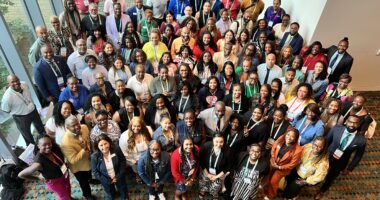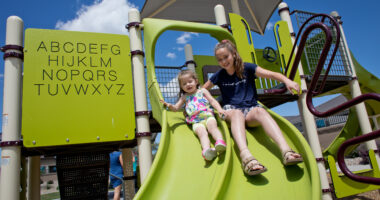NAESP Releases New Principal Guide To Early Learning And The Early Grades
Created in partnership with the National P–3 Center at CU Denver, this guide helps leaders create a school environment that allows the youngest learners to grow and thrive.

Alexandria, VA—March 11, 2021—NAESP, in partnership with the National P–3 Center, is proud to announce the release of a new guidebook, Leading Learning Communities: A Principal’s Guide to Early Learning and the Early Grades (Pre-K–3rd Grade). The guide is developed by and for principals and articulates a vision and practical strategies leaders in early learning and elementary schools can use to create transformational practices for young children.
Learn about the new guide at this panel discussion:
Being an Effective Pre-K–3rd Grade Principal
Tuesday, March 23 at 4 p.m. ET | Register
“The role of the principal is increasingly complex and ever-shifting,” said NAESP Executive Director Dr. L. Earl Franks, CAE. “With a special focus on early learning education, principals play a vital role in helping the youngest learners—from Pre-K through third grade—thrive and continue to grow. We hope principals use this guide to align Pre-K learning experiences with early elementary grades to set up these young learners for success.”
Backed by relevant and recent research findings, the guide defines six competencies to help elementary school principals navigate aligning Pre-K–3rd grade—for children, families, and the adults who serve them within a school—and practical strategies that will support these competencies.
- Competency 1: Understand Child Development and Its Implications for High-Quality Instruction and Interactions, Pre-K–3rd Grade
- Competency 2: Develop and Foster Partnerships with Families and Communities
- Competency 3: Embrace and Enact a Pre-K–3rd Grade Vision
- Competency 4: Ensure Equitable Opportunities
- Competency 5: Share Leadership and Build Professional Capacity
- Competency 6: Promote a Culture of Continuous Improvement
The guide is a tool in and of itself, but it also connects principals to additional resources and references that can be used to go deeper into a topic area. The guide provides examples of the concepts in practice and includes elements to intentionally support principals’ knowledge, skills, planning, and leadership. This includes:
- Spotlights on Effective Practice: Stories of effective practice are presented for each competency to provide a variety of strategies for readers, regardless of the context in which they work. These spotlights are intended to demonstrate effective practices happening in elementary schools across the country that are making a difference in pre-K–3rd grade learning.
- Reflective Assessments: To encourage principals to engage and reflect on their own practices, a series of self-assessment items are outlined for each competency, providing guidance for principals to reflect on their own efforts and to encourage discussion and inquiry with others in their school or community. Space is provided to cite the evidence principals use to track progress on each item and to determine action items.
- Additional Resources: Each competency contains links, resources, and references, so principals and others who are interested can go deeper to learn more about key issues.
“The understanding of how to provide equitable and high-quality learning opportunities to young children not just in pre-k, but also throughout the primary grades, has grown in the past 10 years,” said Dr. Kristie Kauerz, director of the National P-3 Center. “This guide brings together current research and field-proven strategies about reforming elementary schools to effectively engage and support young learners and their families.”
Access the Leading Learning Communities: A Principal’s Guide to Early Learning and the Early Grades (Pre-K–3rd) executive summary and full publication on NAESP’s website.




